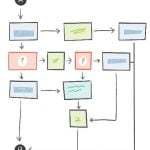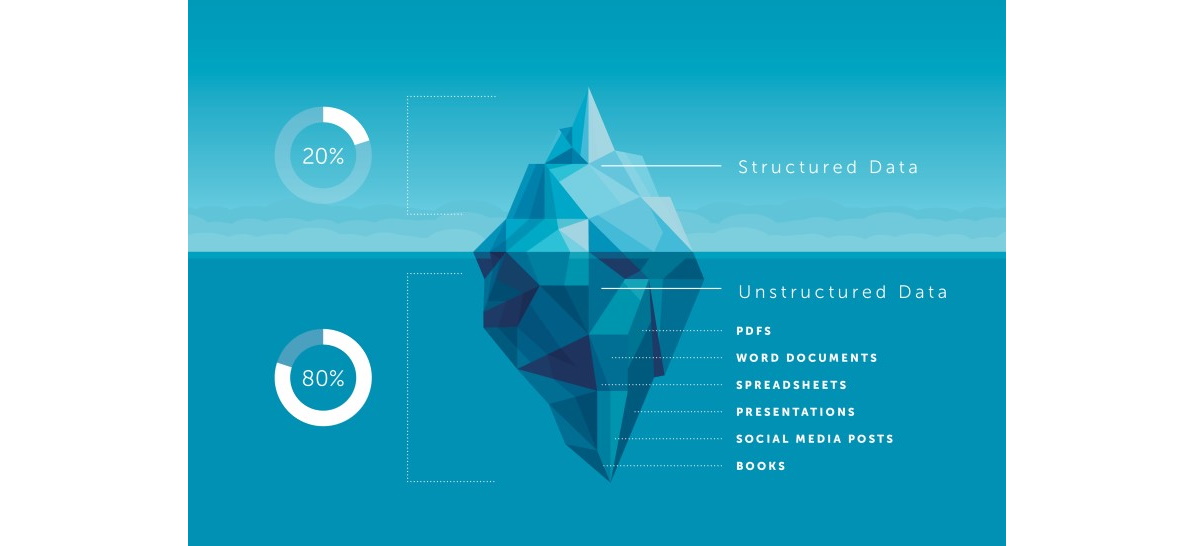From traditional to cognitive RPA
Given the incredible results and ROIs achieved using traditional RPA (Robotic Process Automation), Cognitive RPA can be the next step in innovating the automation of business processes. Cognitive RPA is based on the already consolidated functionalities of classical RPA and leverages the power of artificial intelligence, machine learning, and more consolidated or upcoming technologies. This versatile combination of technologies will overcome the current limitations of RPA, increase information processing capabilities, and reduce the need for human intervention.
Unstructured data
Whether it is invoices, emails, forms, or any business documents, processing structured data is usually an easy job for RPA. However, when the data comes in an unstructured format, then the problems arise.
Many market studies conclude that nowadays, around 80% of the data generated and used by businesses comes in an unstructured format. Companies can leverage unstructured data using RPA and complementary technologies, streamlining their processes, or extracting valuable information. Manually identifying and performing such processes is impossible to do in a reasonable time.
If the data doesn’t come in a structured manner, based on general rules and constraints, the document understanding approaches differ from traditional RPA. When we talk about processing and understanding documents, we generally refer to the extraction of information from them and the manipulation of that information. For this type of operation, the following cases have often raised issues:
- varying templates
- handwriting
- signatures
- checkboxes
- skewed
- scanned documents
For businesses to process unstructured data and translate it into structured data, companies can use the AI (Artificial Intelligence) and ML (Machine Learning) capabilities that RPA tools have begun to integrate and refine.
Machine Learning can be used to train models that can recognize information patterns where there are no well-defined initial templates. The user can check the correctness and validity of the extracted data based on the models trained by ML, and these can be updated according to the human input and feedback.
Speech-to-Text engines are easy to integrate into top RPA tools and can be an effective way to convert unstructured data received as audio into useful, structured data. They say that the capabilities of this type represent the ears of the robots.
Optical Character Recognition (OCR) is a crucial technology that many RPA tools have it integrated. It gives robots the ability to read, solving the problem of understanding, and extracting text from scanned documents.
If Speech-to-Text capabilities can be considered to be the ears of the robots, Computer Vision, as expected, would be their eyes. By making use of neural networks complemented with custom Screen OCR and other technologies, Computer Vision in RPA can eliminate or reduce the reliance on traditional selectors and facilitate Citrix and VDI automation.
Robots reliability
If you want to keep the operation of a robot stable and efficient, then assessments and maintenance are a must.
Processes involving a broad architecture, based on multiple applications and dynamic graphical interfaces, need constant attention, repair, and improvement. Cognitive RPA can be used to give robots the ability to understand contexts and to heal on their own when the state they are in is not a valid one or when UI element indicators fail due to changes.
Process exceptions handling
Following the human users’ methodology of evaluation and validation of information, robots can learn on their own how to deal with certain scenarios. By doing this, the number of exceptions that need to be handled by humans decreases as the robot can handle more and more edge cases on its own.
User interaction
Natural Language Processing is a branch of linguistics and information technology generally used in the interaction between systems and human users. By using terminology extraction and natural language understanding, versatile robots can be built that can understand complex commands and link multiple sequences of actions according to the specifications given by the user. It can be very useful and efficient for use cases such as contract analysis, medical document processing, invoice processing, and many more.
These are all very interesting technologies that already have value and are worth watching to see how they will evolve and what their impact will be. We have experimented with and used some of these technologies in apps for our clients. Most of the new technologies we apply in innovations we develop during our hackathons, which we have these days virtually. Interested to know more, then send us an email.
Alex Dreptate, RPA Developer
STAY TUNED
Subscribe to our newsletter today and get regular updates on customer cases, blog posts, best practices and events.













